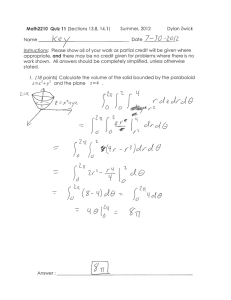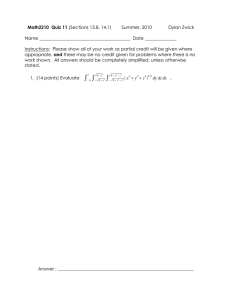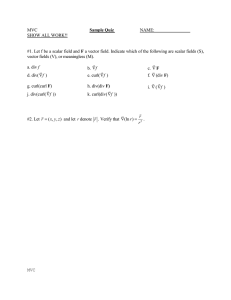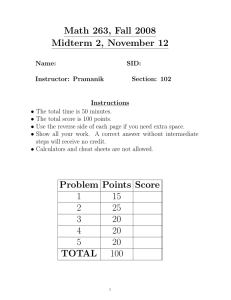The of a vector field is the flux per unit volume. divergence The of a
advertisement
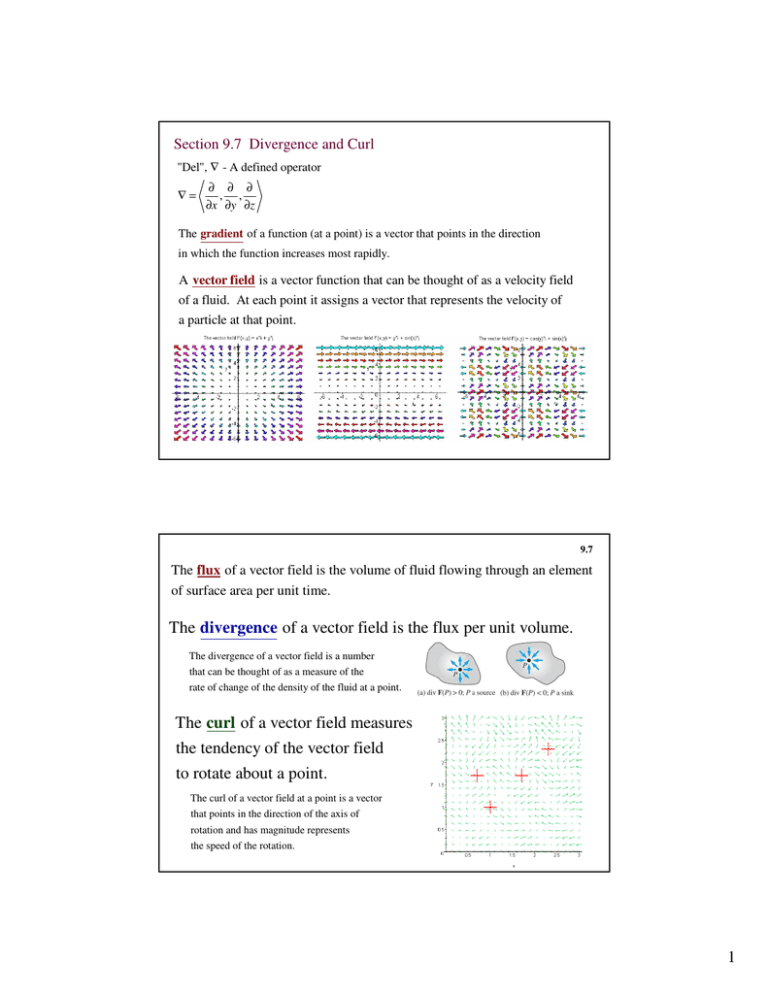
Section 9.7 Divergence and Curl "Del", ∇ - A defined operator ∇= ∂ ∂ ∂ , , ∂x ∂y ∂z The gradient of a function (at a point) is a vector that points in the direction in which the function increases most rapidly. A vector field is a vector function that can be thought of as a velocity field of a fluid. At each point it assigns a vector that represents the velocity of a particle at that point. 9.7 The flux of a vector field is the volume of fluid flowing through an element of surface area per unit time. The divergence of a vector field is the flux per unit volume. The divergence of a vector field is a number that can be thought of as a measure of the rate of change of the density of the fluid at a point. The curl of a vector field measures the tendency of the vector field to rotate about a point. The curl of a vector field at a point is a vector that points in the direction of the axis of rotation and has magnitude represents the speed of the rotation. 1 V ector Field Scalar Funct i on F = P ( x, y, z ) , Q ( x, y, z ) , R ( x, y, z ) f ( x, y, z ) grad ( f G ra dient ∇f = ) fx , f y , fz D iv e rgence div ( F ) ∇ ⋅F = ∂ ∂ ∂ ∂P ∂Q ∂R , , ⋅ P, Q, R = + + = Px + Q y + R z ∂x ∂y ∂z ∂x ∂y ∂z C url curl ( F ) ∇×F = i j ∂ ∂x P ∂ ∂y Q k ∂ = ( R y − Q z ) i − ( R x − Pz ) j + ( Q x − Py ) k ∂z R ∇ × F = R y − Q z , − ( R x − Pz ) , Q x − Py 9.7 F ( x, y, z ) = xe − z , 4 yz 2 ,3 ye − z div ( F ) = ∇ ⋅ F = ∂ ∂ ∂ , , ⋅ xe − z , 4 yz 2 ,3 ye − z = e − z + 4 z 2 − 3 ye − z ∂x ∂y ∂z i ∂ curl ( F ) = ∇ × F = ∂x xe − z j ∂ ∂y 4 yz 2 k ∂ = 3 e − z − 8 yz 2 , − 0 − ( − xe − z ) , 0 ∂z 3 ye − z ( ) 3 e − z − 8 yz 2 , − xe − z , 0 9.7 2 grad ( scalar function ) = V ector F ield div ( V ector F ield ) = scalar function curl ( V ector F ield ) = V ector F ield Which of the 9 ways to combine grad, div and curl by taking one of each. Which of these combinations make sense? grad ( grad ( f ) ) div ( grad ( f ) ) V ector F ield V ector F ield grad ( div ( F ) ) div ( div ( F ) ) scalar function 0 curl ( grad ( f ) ) vector V ector F ield curl ( div ( F ) ) scalar function grad ( curl ( F ) ) V ector F ield scalar function 0 curl ( curl ( F ) ) div ( curl ( F ) ) scalar V ector F ield 2 of the above are always zero. V ector F ield 9.7 Verify the given identity. Assume continuity of all partial derivatives. curl ( grad ( f ) ) = 0. grad ( f ) = f x , f y , f z i ∂ curl ( grad ( f ) ) = ∇ × ∇f = ∂x fx j ∂ ∂y fy k ∂ ∂z fz ∇ × ∇f = f zy − f yz , − ( f zx − f xz ) , f yx − f xy = 0 since mixed partial derivatives are equal. Verify the given identity. Assume continuity of all partial derivatives. div ( curl ( F ) ) = 0. Let F = P ( x, y, z ) , Q ( x, y, z ) , R ( x, y, z ) curl ( F ) = Ry − Qz , Pz − Rx , Qx − Py i ∂ curl ( F ) = ∇ × F = ∂x P div ( curl ( F ) ) = ( Ry − Qz ) x + ( Pz − Rx ) y + ( Qx − Py ) z j ∂ ∂y Q k ∂ ∂z R div ( curl ( F ) ) = Ryx − Qzx + Pzy − Rxy + Qxz − Pyz div ( curl ( F ) ) = Ryx − Qzx + Pzy − Rxy + Qxz − Pyz = 0 9.7 3
